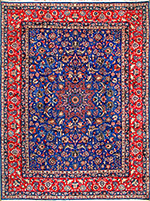Textiles Studies

Textile Research Works
Date of this Version
2000
Document Type
Article
Citation
Forma, 15, 127–132, 2000
Abstract
Patterns in nature result from dynamic relationships of forces and constraints. What is analogous for patterns in art? Art is created by human hands motivated by inspiration and thought. It is the product of creativity and skill. Creativity is constrained by cognitive processes and skill by the limits of technology. Based upon the author’s studies of Oriental carpets, this paper suggests that patterns in art result from dynamic relationships of choices and constraints. Typically, traditional Oriental carpets from historical rug-weaving regions of the world exhibit a multiplicity of patterns—field patterns and border patterns that express a vast array of designs and various possibilities for their repetition in linear arrangement or to cover a plane. In classical Oriental carpets, the repetition of a design to cover a pattern is accomplished by counting and repeating sequences of knots. This paper explores dynamic relationships of choices and constraints, by which weavers have used both symmetry and symmetry-breaking to transform repetitive patterns into great works of art.
Included in
Art and Materials Conservation Commons, Art Practice Commons, Fiber, Textile, and Weaving Arts Commons, Indigenous Studies Commons, Museum Studies Commons

